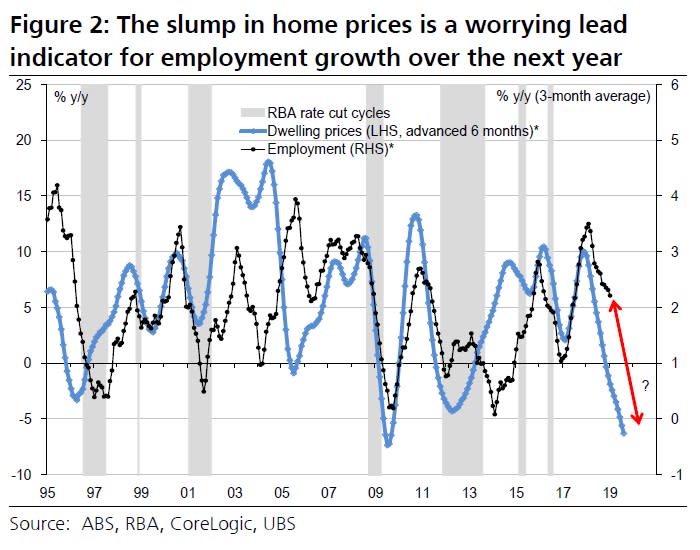Here's a worrying chart for jobs growth

Australian home prices have fallen 6.3% over the past year, the steepest decline since the GFC.
Where home prices move, Australian employment growth tends to follow.
If prior relationships are maintained, employment growth may slow sharply in the coming months, potentially leading to higher unemployment if participation rates hold at current levels.
The RBA has nominated a sustained increase in unemployment as one outcome that could see it cut Australia’s cash rate.
Now here’s a worrying chart on the outlook for Australian employment growth.

From UBS, it shows the annual percentage change in Australia’s median home price, overlaid against the annual percentage change in Australian employment. The former has been advanced by six months to show that employment tends to lag movements in prices.
While not a perfect relationship, it’s a pretty good fit.
More often than not, where home prices move, employment tends to follow.
Right now, the 6.3% decline in Australia’s median home price over the past year — the largest since the GFC — indicates that employment growth may slow sharply in the months ahead.
There’s already signs that’s happening with annual growth in employment easing from around 3.5% per annum to 2.2% in January in a little over a year.
If that trend continues — and it looks like it might given the prior relationship with home prices — it may start to put upward pressure on inflation if participation rates within the jobs market remain at current levels.
For the RBA, that could be enough to see it cut Australia’s cash rate given it’s already indicated that a sustained increase in unemployment is one outcome that could see it ease policy settings further.
UBS is among a small-yet-growing group of forecasters who believe the RBA will have to do just that.
“We remain non-consensus, expecting GDP to clearly slow to a below-trend pace of 2.3% this year, seeing unemployment rise and the RBA cut interest rates in November with risk of earlier easing,” says George Tharenou, Economist at UBS.
–Business Insider Australia
Make your money work with Yahoo Finance’s daily newsletter. Sign up here and stay on top of the latest money, news and tech news.
Now read: Women CEOs will have to wait another 80 years for parity with men
Now read: Atlassian to find a home in a new tech precinct dubbed Sydney’s ‘Silicon Valley’
Now read: Chart: The cost of sick days to the Australian economy

 Yahoo Finance
Yahoo Finance 
